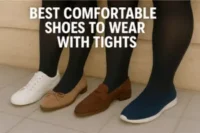What Shoes to Wear in Greece (2025 Guide)
Published: 27 Aug 2025
Why Shoes Matter More Than You Think
Planning a trip to Greece? You’re probably excited about the whitewashed villages, sunny beaches, and ancient ruins. But before you pack your bags, there’s one thing you really need to get right—your shoes.
Many travelers overlook this part. They throw in a random pair of sandals or sneakers and think they’re ready. But Greece is not your average vacation spot. It’s full of cobblestone streets, steep stairs, and slippery marble paths—especially in places like Athens and Santorini. If you wear the wrong shoes, you’ll feel it by day two. Blisters, sore feet, and awkward stumbles can quickly ruin the fun.
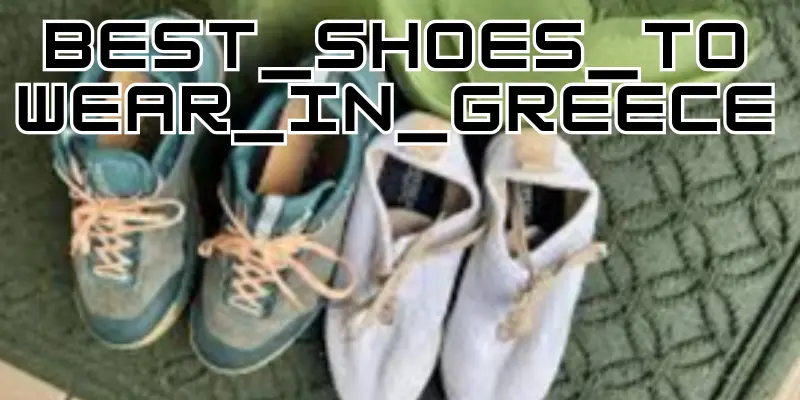
That’s why this guide focuses on what shoes to wear in Greece. Whether you’re island hopping, exploring ancient ruins, or strolling through local markets, your shoes should help—not hurt—you. We’ll walk through the best options for every situation, season, and style.
You’ll also learn what not to wear, how to pack smart, and how to pick shoes that fit in with local style—so you don’t look like a tourist. Sound good?
1. Understanding the Greek Terrain & Travel Context
Before you decide what to wear, you need to understand where you’re walking. Greece may look dreamy in photos—and it is—but its streets, paths, and landscapes can surprise you if you’re not prepared.

A Mix of Ancient and Modern
Cities like Athens have a blend of old and new. One moment you’re walking on smooth pavement, and the next, you’re climbing worn marble steps at the Acropolis. These stones are polished from centuries of foot traffic—yes, they’re beautiful, but also slippery.
Meanwhile, charming villages like Oia in Santorini or Parikia in Paros are full of narrow alleyways, cobblestone streets, and uneven stairs. They’re stunning. But wearing flat, unsupportive shoes here? Not a good idea.
Coastal & Island Life
If you’re heading to the islands—Mykonos, Naxos, Crete, or any of the others—you’ll be walking on sandy beaches, dusty roads, and rocky trails. Some islands have strong summer winds too, which can make your flowy skirt and flip-flops a bad combo on a cliffside path.
Ferries are another part of the travel puzzle. You’ll be boarding boats, climbing stairs, and moving across slick decks. You’ll need shoes that are grippy, sturdy, and easy to slip on and off.
Day-to-Night Adventures
In Greece, it’s common to start your day sightseeing and end it with a sunset dinner by the sea. That means your shoes should work for both comfort and style. You want something that won’t slow you down—but also looks good in those vacation photos.
Real example: One traveler shared how her leather sandals looked cute but had zero support. After one day exploring Athens, she had to buy emergency sneakers because her feet were killing her. Don’t let that be you.
So before we get into the best shoes for different activities, remember this: Greece is more rugged, more ancient, and more varied than you think. Picking the right shoes isn’t just about fashion. It’s about comfort, safety, and making sure your trip goes smoothly—from the first step to the last.
2. The Ultimate Footwear Breakdown by Travel Situation
Every day in Greece brings something new—city walks, beach time, ancient ruins, or ferry rides. You need the right shoes for each part of your trip. Here’s a breakdown of the best options based on real travel situations.
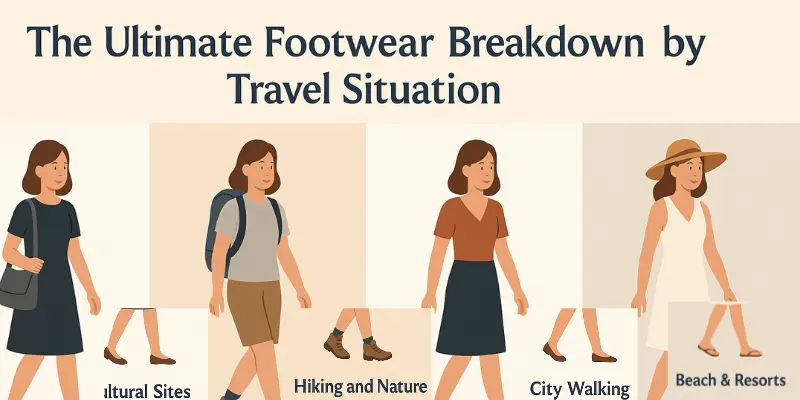
City Strolling & Sightseeing
Think Athens, Thessaloniki, or smaller mainland towns.
- Best shoes: Cushioned walking sneakers or breathable slip-on shoes
- Why: You’ll be walking on cobblestones, uneven pavements, and ancient sites like the Acropolis
- Look for: Arch support, padded soles, non-slip grip, and breathable fabric
- Style tip: Go for neutral-colored sneakers that can work for day and casual evening looks
Example: A pair of lightweight mesh sneakers with memory foam soles works great for walking around Plaka in Athens without sweaty feet or sore arches.
Beach Days & Coastal Walks
Heading to Santorini, Naxos, or Zakynthos?
- Best shoes: Water shoes, flip-flops, or cushioned slides
- Why: You’ll walk on hot sand, pebble beaches, and maybe rocky paths to secret coves
- Look for: Quick-drying material, easy to rinse, good foot grip
Tip: Some Greek beaches are rocky (like Lalaria Beach or Myrtos), so water shoes help protect your feet and give better traction in the water.
Island Hopping & Ferries
Think daily boat rides, port walks, and quick outfit changes.
- Best shoes: Hiking sandals, travel sandals with adjustable straps, or sturdy flip-flops
- Why: You need comfort, support, and convenience
- Look for: Anti-slip soles, easy on/off design, water resistance
Pro tip: Choose sandals that can go from beach to bar. Brands like Teva and Birkenstock offer great options that are both stylish and functional.
Exploring Ancient Ruins & Historic Sites
Planning to see Delphi, Knossos, or Olympia?
- Best shoes: Trail runners, travel sneakers, or hybrid hiking shoes
- Why: These areas often have dusty, uneven paths, loose stones, and long walking distances
- Look for: Strong grip, cushioned soles, breathable fabric
Traveler tip: Many ruins involve climbing or uneven surfaces. Sneakers with a good tread and arch support make all the difference.
Evenings Out: Style Meets Stability
Dinner in Mykonos Town or a rooftop drink in Athens?
- Best shoes: Low wedges, dressy sandals, or foldable flats
- Why: You’ll still be walking, just slower—and on the same uneven ground
- Look for: Closed-toe or secure sandals with solid soles
- Avoid: High heels or thin, slippery soles
Bonus tip: Metallic or neutral-colored shoes work with almost any outfit and blend beautifully with Greece’s evening style.
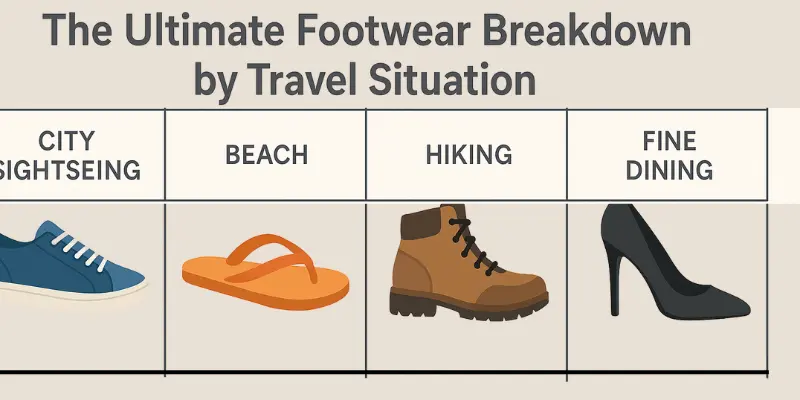
In Summary
| Travel Situation | Best Shoe Type | Why It Works |
| City Strolling | Cushioned sneakers | All-day comfort, good grip, casual style |
| Beach & Water Activities | Water shoes or flip-flops | Sand, rocks, and easy rinse-off |
| Island Hopping | Travel sandals | Easy on/off, ferry-friendly, beach-to-town wear |
| Ancient Sites | Trail runners | Strong grip, ankle support, stability |
| Evenings Out | Flats, wedges, sandals | Looks great, still walkable on stone streets |
The key is to match form with function. Greece is a mix of beauty and unpredictability—so your shoes need to be ready for anything.
3. Greek Shoe Etiquette: What Not to Wear
Greece is laid-back—but that doesn’t mean anything goes when it comes to footwear. If you want to blend in, stay comfortable, and show respect in the right places, there are a few shoes you should leave behind.
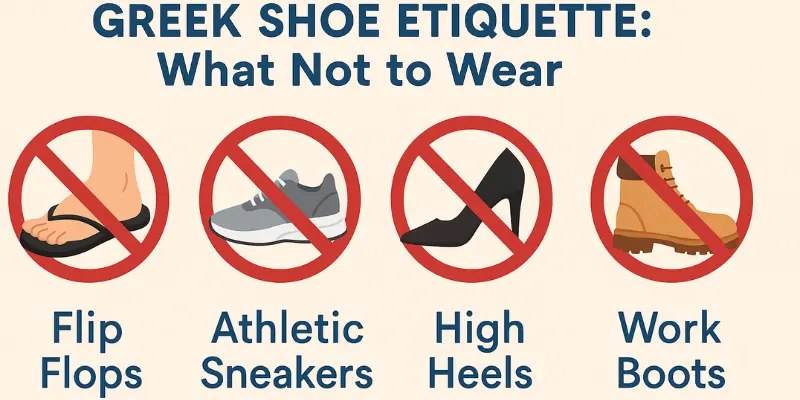
Let’s walk through the biggest mistakes tourists make with their shoes.
🚫 High Heels on Cobblestones
It may look cute in vacation photos, but wearing high heels on Greek streets is a disaster waiting to happen. Cobblestones and polished marble are uneven and slippery. You’ll twist an ankle—or worse.
Better choice? Try low wedges or chunky-heeled sandals if you want some height without the pain.
🚫 Cheap Flip-Flops for All-Day Walking
Sure, flip-flops are great for the beach. But for sightseeing or wandering around towns like Nafplio or Chania? Your feet will feel every crack in the pavement.
Better choice? Wear supportive slides or water sandals that have grip and cushioning.
🚫 Slippery Soles
Some fashion shoes have smooth bottoms that look fine but are dangerous on stone surfaces—especially when it rains or you’re walking near water.
Better choice? Always choose shoes with non-slip soles, especially if you’re visiting ancient ruins or hilly villages.
🚫 Overly Flashy or Loud Gym Shoes
Locals keep it stylish and simple. Bright neon sneakers or overly sporty shoes can scream “tourist.” Greece leans toward neutral tones, simple styles, and quality over flash.
Better choice? Stick to clean, comfy sneakers in white, tan, or earth tones. These match most outfits and fit in better with local fashion.
🚫 Revealing Shoes at Religious Sites
Planning to visit a monastery or church? Respect the culture. Avoid strappy sandals or bare feet at these sacred places.
Better choice? Wear closed-toe flats or simple sandals and bring a shawl or scarf to cover your shoulders and knees, too.
Quick Checklist: What Not to Wear in Greece
- ❌ High heels
- ❌ Flat, unsupportive flip-flops
- ❌ Smooth-soled shoes
- ❌ Flashy gym shoes
- ❌ Revealing footwear at religious sites
Real Tip: One traveler shared she wore stylish flats with slippery soles to the Parthenon. On her first step, she almost fell—and ended up holding onto the wall the whole way up. She switched to grippy sneakers the next day and never looked back.
The bottom line? Greece rewards travelers who dress smart. Choose shoes that respect the landscape, the culture, and your own comfort.
4. Regional Shoe Guide: Dress for the Destination
Greece isn’t one-size-fits-all. What works in Athens might not work on the cliffs of Santorini or the trails of Crete. That’s why smart travelers pack based on where they’re going—not just what they’re doing.
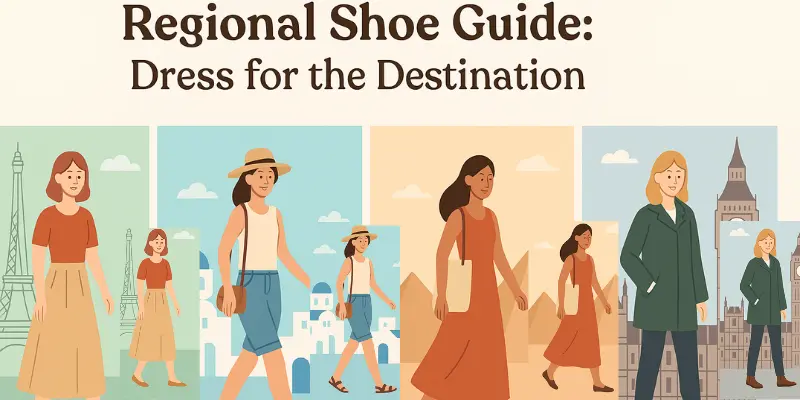
Let’s break it down region by region so you know exactly what shoes to wear in each part of Greece.
Athens: Style Meets History
- Best shoes: Cushioned sneakers or stylish walking shoes
- Why: You’ll walk a lot—between ancient ruins, museums, shops, and rooftop bars
- Style tip: Locals dress casually but put-together. Clean, neutral sneakers fit right in
Example: A comfy pair of white sneakers can take you from climbing the Acropolis to dinner in the Plaka.
Santorini: Cliffs, Sunsets & Stairs
- Best shoes: Strappy sandals (with grip), low wedges, or flexible flats
- Why: Think of the winding steps in Oia and steep alleys around Fira. You need grip and balance
- Avoid: Thin soles or anything unstable—those cliffside views come with tricky paths
Bonus tip: Stylish sandals in tan or gold look amazing against the white-and-blue backdrop.
Mykonos: Beach Days + Nightlife
- Best shoes: Slides for beach clubs, dressy sandals for town
- Why: You’ll go from beach to party to dinner—sometimes all in one night
- Look for: Shoes that are easy to clean (sand everywhere) but still trendy enough for the scene
Pro tip: Leave the heels. Go for flat sandals with gold accents or embellished straps.
Crete: Adventure-Ready Terrain
- Best shoes: Trail shoes, supportive sneakers, or hiking sandals
- Why: Crete is big and wild—expect hikes, gorges, and long drives
- Where: For places like Samaria Gorge, you’ll need real grip and ankle support
Smart pick: A breathable trail runner or a hybrid hiking sandal that can handle dust and rocks.
Naxos, Paros & the Quieter Islands
- Best shoes: Espadrilles, breathable flats, or comfy sandals
- Why: These islands are slower-paced with charming villages and beach vibes
- Style tip: Simple, soft-soled shoes work best on quiet streets and beach walks
Look for: Lightweight shoes with soft soles and flexible fabric—perfect for strolling at sunset.
Mainland & Northern Greece (Delphi, Meteora, Thessaloniki)
- Best shoes: Durable walking shoes or waterproof boots (in colder months)
- Why: Varied terrain—think ancient ruins, mountain roads, and cooler weather
- Seasonal note: If you’re traveling in fall or winter, pack something warm and water-resistant
Quick Recap: Best Shoes by Region
| Region | Best Shoes | Why It Works |
| Athens | Cushioned sneakers | City walking, casual but stylish look |
| Santorini | Grippy sandals, wedges | Steps, cliffs, photo-ready looks |
| Mykonos | Slides, trendy sandals | Beach to bar, sand-friendly fashion |
| Crete | Trail shoes, hiking sandals | Big landscapes, adventure-ready |
| Naxos & Paros | Espadrilles, flats, sandals | Village charm, relaxed pace |
| Northern Greece | Walking shoes, boots (winter) | Ancient sites, cooler temperatures |
Knowing where you’re going helps you pack smart. Each place in Greece has its own vibe—and your shoes should match the journey.
5. Seasonal Footwear Guide for Greece
The weather in Greece changes with the seasons—and so should your shoes. What works in July won’t feel right in November. And while the islands stay warmer, places like Athens, Thessaloniki, and Meteora can get chilly or wet in the off-season.
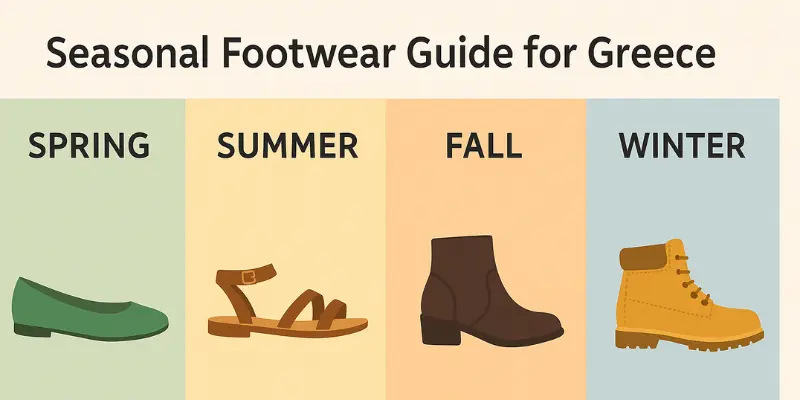
Let’s break it down so you know exactly what shoes to pack for your travel month.
☀️ Summer (June – August)
Hot, dry, and full of sunshine. Perfect for beaches and light travel.
- Best shoes to wear in Greece:
- Lightweight sandals with straps
- Breathable walking sneakers
- Comfortable flip-flops or water shoes for rocky beaches
- Lightweight sandals with straps
- Watch out for:
- Overheating feet in plastic or rubber shoes
- Slippery sandals on marble or cobblestone paths
- Overheating feet in plastic or rubber shoes
- Real tip: Look for sandals with good grip and arch support. You’ll walk more than you think—even on beach days.
🌸 Spring (March – May)
Mild, sometimes breezy. Great for walking tours and exploring ruins.
- Best shoes:
- Cushioned sneakers or slip-ons
- Closed-toe flats
- Light sandals for warm afternoons
- Cushioned sneakers or slip-ons
- Expect:
- A few rainy days in March and early April
- Cool mornings and evenings
- A few rainy days in March and early April
- Packing tip: Bring a pair of socks and a light jacket. If you’re hiking, choose shoes with non-slip soles.
🍂 Fall (September – November)
Warm at first, cooler later. Ideal season for sightseeing.
- Best shoes:
- Supportive walking shoes or sneakers
- Stylish loafers or ballet flats
- Optional: Water-resistant shoes for October/November
- Supportive walking shoes or sneakers
- Travel note:
- September still feels like summer
- October and November bring cooler temps, especially in the north
- September still feels like summer
- Smart pick: Shoes that work for both city walks and day trips—think hybrid sneakers or versatile loafers.
❄️ Winter (December – February)
Cool and wet in most places. Snow is rare, but rain is common.
- Best shoes:
- Warm, cushioned sneakers
- Ankle boots with grip
- Waterproof shoes if exploring outdoors
- Warm, cushioned sneakers
- Avoid:
- Sandals (unless you’re visiting the southern islands)
- Thin-soled shoes without padding
- Sandals (unless you’re visiting the southern islands)
- Pro tip: Choose shoes you can walk in for hours—Greece in winter is all about museums, local markets, and hidden cafes.
📌 Shoe Quick Guide by Season
| Season | Best Shoe Types | Why It Works |
| Summer | Sandals, flip-flops, breathable sneakers | Hot weather and beach activities |
| Spring | Sneakers, light sandals, flats | Mild temps, some rain, lots of walks |
| Fall | Cushioned sneakers, water-resistant flats | Cooler days, changing weather |
| Winter | Boots, waterproof sneakers | Rain, cooler temps, longer walks |
Need a simple rule?
✅ Always pack one pair for walking, one for relaxing, and one for going out.
That combo works in every season—just change the style based on the weather.
6. Packing Smart: The 3-Pair Shoe System
You don’t need to pack your whole shoe rack for Greece. In fact, most travelers only need three pairs—just three! If you choose wisely, you’ll cover everything from hiking trails to sunset dinners without overloading your suitcase.
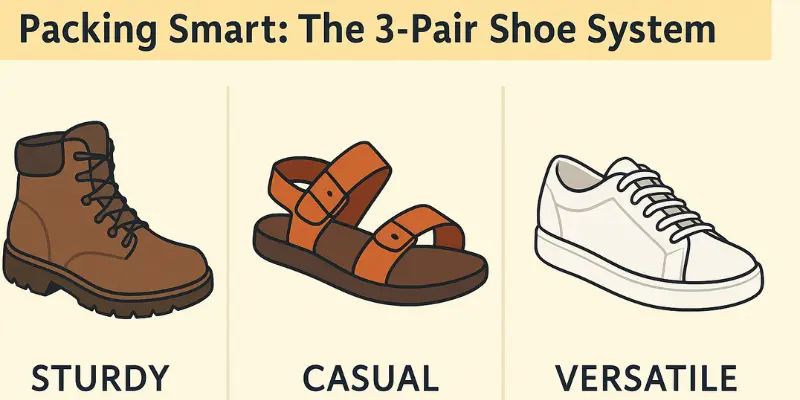
Let’s break down the simple and smart 3-pair shoe system for your trip to Greece.
👟 Pair #1: All-Day Walking Shoes
This is your everyday go-to. You’ll wear them on city tours, day trips, ancient ruins, and airport travel.
- Best options:
- Lightweight sneakers
- Supportive walking shoes
- Breathable slip-ons with arch support
- Lightweight sneakers
- Why you need them:
- Perfect for Athens, ruins, and urban sightseeing
- They keep your feet happy during long walks on cobblestones, marble paths, or stone stairs
- Perfect for Athens, ruins, and urban sightseeing
- Travel tip: Go for neutral colors like white, beige, or grey so they work with every outfit.
🩴 Pair #2: Sandals or Slides for Warm Days
This pair is for island life, beach days, and relaxed strolls.
- Best options:
- Hiking sandals (like Teva or Chaco)
- Leather sandals or espadrilles
- Simple, supportive flip-flops or slides
- Hiking sandals (like Teva or Chaco)
- Why you need them:
- Keeps your feet cool in summer
- Easy to slip on/off at the beach or ferry
- Great for coastal towns like Mykonos, Naxos, or Santorini
- Keeps your feet cool in summer
- Style tip: Choose a pair that looks good with both swimwear and casual dinner outfits.
🥿 Pair #3: Evening Shoes or Versatile Extras
Your third pair depends on your travel style—but it’s usually something a little more polished.
- Best options:
- Cute ballet flats or foldable loafers
- Low wedges or dressy sandals
- Slip-on shoes that can pass for semi-formal
- Cute ballet flats or foldable loafers
- Why you need them:
- For restaurants, bars, or evenings out
- Some churches or museums may require closed-toe shoes
- Easy to pair with dresses or tailored pants
- For restaurants, bars, or evenings out
- Pro tip: If you’re tight on space, pick shoes that can fold flat or pack into a side pocket.
🧳 How to Pack Shoes Without Wasting Space
- Use packing cubes or reusable cloth bags
- Stuff socks or underwear inside your shoes to save space
- Place heavier shoes at the bottom of your luggage
- Wear your bulkiest pair (usually sneakers) on the plane
🧠 Bonus Tip: Customize Based on Season & Activities
| Season | Suggested 3 Pairs |
| Summer | Sneakers, sandals, flip-flops |
| Spring/Fall | Sneakers, water-resistant flats, sandals |
| Winter | Warm sneakers, ankle boots, loafers |
Packing smart means more room for souvenirs and fewer “I packed too much” regrets. With just three solid pairs, you’ll be ready for every adventure Greece throws your way—and your feet will thank you.
7. Comfort First: Blister Prevention, Swelling & Fatigue Fixes
Exploring Greece means a lot of walking on cobblestones, hills, dusty paths, and even slick marble stairs. If your feet aren’t happy, your trip won’t be either.
Here’s how to avoid common foot problems like blisters, swelling, and tired feet, so you can enjoy every step of your adventure.
👣 1. Stop Blisters Before They Start
Blisters are one of the most common travel problems—and they’re easy to prevent.
- Do this before your trip:
- Break in your shoes! Don’t wear anything brand new on Day One
- Try walking around at home or doing short errands in them
- Use blister prevention tape or moleskin on common friction spots (heels, sides, toes)
- Break in your shoes! Don’t wear anything brand new on Day One
- Pack these just in case:
- Blister bandages (like Compeed or Band-Aid Hydro Seal)
- Travel-size foot powder or anti-chafing balm
- Blister bandages (like Compeed or Band-Aid Hydro Seal)
Pro tip: If your shoes rub even a little during your first wear, they will give you blisters in Greece.
🧦 2. Keep Feet Dry and Cool
Hot, sweaty feet = discomfort and odor.
Here’s how to stay fresh, especially during Greek summer:
- Choose breathable shoes made with mesh or quick-dry fabrics
- Wear moisture-wicking socks (not cotton)
- Rotate your shoes if possible—let one pair air out while you wear the other
Bonus tip: Sprinkle baking soda or foot powder inside your shoes overnight to keep them dry and odor-free.
🧊 3. Fight Foot Swelling (It’s Common!)
Warm weather and long days can lead to swelling—especially on flights or ferries.
- To prevent swelling:
- Wear compression socks during flights or long travel days
- Elevate your feet at night for a few minutes
- Stretch your toes and roll your ankles regularly
- Wear compression socks during flights or long travel days
- Cooling tip: Bring a small roller ball or travel-size gel pack to massage sore feet after a long day.
Example: Many travelers wear compression socks on the plane and switch to sandals after landing—best of both worlds!
💪 4. Strengthen & Support Tired Feet
If you’re walking 10,000+ steps a day (and you probably will), give your feet extra support.
- Add gel insoles or arch supports to your sneakers
- Do a few easy foot stretches in the morning and before bed
- Massage your soles using a tennis ball or frozen water bottle
🧳 Your “Happy Feet” Travel Kit
Make space for these in your bag:
- ✅ Blister patches
- ✅ Travel-size foot powder
- ✅ Compression socks
- ✅ Gel insoles
- ✅ Moisture-wicking socks
- ✅ Foot roller or mini massage ball
Taking care of your feet is just as important as picking the right shoes. Comfort isn’t a luxury when you’re exploring Greece—it’s a must.
8. Style-Boosting Footwear Tips
Let’s be honest—you want to look good in Greece. From iconic Santorini photos to relaxed dinners by the sea, your shoes should match your style while still being practical.
The good news? You can have both. Here’s how to pick shoes that are comfortable, versatile, and Instagram-worthy—without sacrificing your feet.
👟 1. Stick to Neutral Colors
Beige, tan, white, black, and olive tones work with almost anything you pack.
- They don’t clash with bright summer dresses or patterned shirts
- They blend in with Greek style, which is simple and understated
- Dust and scuffs don’t show as easily as they do on bright shoes
Example: A white pair of sneakers can go with shorts, sundresses, or even a linen jumpsuit.
🥿 2. Choose Shoes That Work Day to Night
Your shoes should be able to do double duty. No need to carry five different pairs.
- Pick sandals or flats that look just as good with a swimsuit as they do with a casual dress
- Wear sneakers that are sleek enough for city strolls and casual dinners
- Avoid shoes that are too sporty, bulky, or flashy—they’re harder to style
Pro tip: Espadrilles, leather slides, or gold-tone sandals are great for dressy looks and comfortable walking.
👜 3. Match Footwear with Accessories
Yes—your shoes and accessories should get along.
- Pair tan sandals with a woven crossbody bag or raffia sun hat
- If you wear metallic sandals, match them with gold jewelry
- Want to add color? Do it with your scarf or bag, not your shoes
Style idea: A linen dress + neutral sandals + straw tote = effortless Greek vibe.
🧼 4. Keep Them Looking Fresh
Stylish shoes can’t be worn out and dirty. Here’s how to keep them looking good:
- Wipe sneakers with a travel-size cleaning cloth
- Use a small brush to clean out sand or dust from sandals
- Pack your shoes in cloth bags so they don’t rub against clothes
Quick fix: Baby wipes or alcohol pads work great in a pinch.
👣 5. Comfort Makes Style Work
Nothing ruins a cute outfit like limping down the street.
So yes, style matters, but comfort comes first. If your shoes hurt, it shows—and not in a good way.
Smart combo:
- Day: Sneakers or sandals with grip
- Night: Stylish flats, slides, or low wedges
- Beach: Water shoes or cushioned flip-flops
💡 Easy Style Tips to Remember
| Style Tip | Why It Works |
| Neutrals over bright colors | Matches everything, looks cleaner |
| Day-to-night designs | Fewer shoes, more outfit options |
| Matching shoes + accessories | Polished, pulled-together look |
| Keep them clean | Fresh shoes = sharp outfit |
| Comfort first | You’ll wear them more, and smile more 😉 |
You don’t need to sacrifice style to stay comfortable in Greece. A few smart choices go a long way—and your travel photos will thank you.
9. Footwear for Every Traveler Type
Not all travelers are the same—and neither are their shoes. Whether you’re a minimalist packer, a trend chaser, or someone chasing toddlers through a village square, your footwear should match your travel style.
Let’s break it down so you can find your perfect shoe combo based on how you explore Greece.
🧳 The Minimalist
You pack light, move fast, and hate checking luggage.
- You need:
- 1 pair of breathable sneakers
- 1 pair of comfy slides or sandals
- 1 pair of breathable sneakers
- Why it works:
- Your shoes double up for beach days and walking tours
- Neutral tones match every outfit
- You save space without sacrificing comfort
- Your shoes double up for beach days and walking tours
Example: A white sneaker + tan travel sandal = fits in a carry-on, works everywhere.
📸 The Style Lover
You’re planning outfits. You’re planning photos. You love to look good—and Greece is your backdrop.
- You need:
- Fashion-forward flats or espadrilles
- Metallic or leather sandals
- Foldable evening flats for fancy dinners
- Fashion-forward flats or espadrilles
- Why it works:
- Stylish but still comfortable
- Great for photos in Santorini or dinner in Mykonos
- Easy to pair with linen sets, dresses, or resort wear
- Stylish but still comfortable
Style tip: Stick to gold, tan, or soft blush tones—they elevate any outfit without standing out too much.
🥾 The Adventurer
You’re hiking gorges, exploring ruins, and always off the main path.
- You need:
- Durable trail runners or hiking sandals
- Waterproof walking shoes for ruins or rough terrain
- Optional: Slides for downtime
- Durable trail runners or hiking sandals
- Why it works:
- Ready for Samaria Gorge, Delphi, or long city walks
- Keeps feet safe on rocky, uneven paths
- You’re prepared for anything—even rain or dust
- Ready for Samaria Gorge, Delphi, or long city walks
Pro tip: Look for shoes with good tread, toe protection, and breathable materials.
👨👩👧 The Family Traveler
You’re chasing kids, planning day trips, and need shoes that last all day.
- You need:
- Cushioned sneakers
- Easy-on sandals or slip-ons
- Something waterproof (for spills, splashes, or sand)
- Cushioned sneakers
- Why it works:
- You need support, grip, and durability
- No time for shoelaces or sore feet
- Your hands (and patience) are full already
- You need support, grip, and durability
Smart tip: Pack matching pairs for kids—makes mornings easier and photos cuter.
🛥️ The Luxury Explorer
You’re staying in boutique hotels, dining at rooftop spots, and enjoying slow, stylish travel.
- You need:
- Elegant flats or low wedges
- Polished leather sandals
- Slip-on loafers or espadrilles
- Elegant flats or low wedges
- Why it works:
- Looks refined, still walkable
- Perfect for upscale dinners or wine tastings
- Adds style without screaming “tourist”
- Looks refined, still walkable
Bonus: Choose quality over quantity—3 great pairs are better than 6 average ones.
👟 Quick Match: Find Your Travel Style
| Traveler Type | Must-Have Pair | Backup Pair |
| Minimalist | Walking sneakers | Travel sandals |
| Style Lover | Dressy sandals | Foldable flats |
| Adventurer | Trail shoes | Water-resistant sandals |
| Family Traveler | Cushioned sneakers | Slip-on shoes |
| Luxury Explorer | Elegant flats or loafers | Leather sandals |
Traveling in Greece isn’t just about where you go—it’s also about how you travel.
Choose the shoes that support your rhythm, your routine, and your real life.
10. Trends to Know: What’s Hot for 2025 Travel
Travel trends change fast—and shoes are no exception. In 2025, it’s all about comfort, versatility, and a touch of quiet luxury. Whether you’re walking through Greek ruins or sipping wine on a cliffside, your shoes can be both stylish and functional.
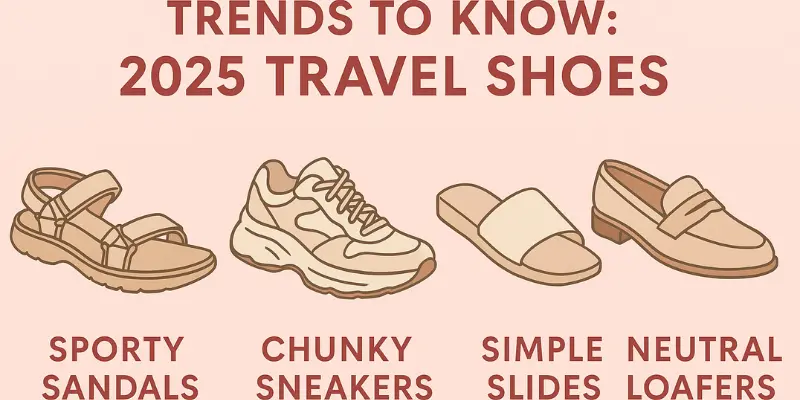
Here’s what’s trending this year in Greek travel footwear.
🩴 1. Strappy Leather Sandals (Still a Classic)
These never go out of style—and in 2025, they’re even more popular.
- Why they’re hot:
- Minimalist, elegant, and match with everything
- Flat styles are in, with soft leather and earthy tones
- Great for island hopping, beach towns, and evening strolls
- Minimalist, elegant, and match with everything
Real tip: Choose sandals with a slight heel or arch support to avoid foot pain on long walks.
👟 2. Sleek, White Travel Sneakers
Chunky “dad shoes” are out. Clean, slim-profile sneakers are in.
- Why they work in Greece:
- Lightweight and perfect for exploring cities like Athens or Thessaloniki
- They go with dresses, shorts, or linen pants
- Most are made with recycled materials, which is another plus
- Lightweight and perfect for exploring cities like Athens or Thessaloniki
Trending brands: Allbirds, Veja, Cariuma, and Thousand Fell.
🩰 3. Foldable Flats & Packable Shoes
2025 travelers are packing smarter. Shoes that fold or flatten are perfect for carry-on travel.
- Look for:
- Ballet flats that fold in half
- Packable loafers or slip-ons
- Lightweight materials with solid soles
- Ballet flats that fold in half
Perfect for: Evenings out, museum visits, or dressy dinners without the weight.
🧘 4. Sustainable & Eco-Friendly Footwear
Eco-conscious travel is in, and your shoes can follow the same path.
- What’s trending:
- Shoes made from bamboo, cork, or recycled plastics
- Brands with carbon-neutral manufacturing
- Styles that are biodegradable or long-lasting
- Shoes made from bamboo, cork, or recycled plastics
Why it matters: Greek tourism focuses more on sustainability each year, especially on islands like Naxos and Paros.
🏖️ 5. Hybrid Sandals (Fashion Meets Function)
People want sandals that look good and can handle serious walking.
- Top features:
- Quick-dry straps
- Grippy rubber soles
- Lightweight yet stylish designs
- Quick-dry straps
Perfect for: Beach towns like Mykonos, where you’re walking all day but still want to look put together.
📷 6. Earth Tones & Soft Metallics
Say goodbye to neon. 2025 is all about natural, muted colors.
- Trending colors:
- Taupe, olive, sand, terracotta
- Soft gold, bronze, and rose-gold sandals
- Taupe, olive, sand, terracotta
Why it’s great for Greece: These tones blend beautifully with Greece’s landscapes and architecture—and look amazing in photos.
👟 What’s Out in 2025?
- ❌ Overly bulky sneakers
- ❌ High heels (still not Greece-friendly)
- ❌ Loud logos and neon colors
- ❌ Cheap, plastic flip-flops that fall apart after two days
🧳 What to Pack if You Want to Stay On Trend:
| Trend | Shoe Type | Where to Wear It |
| Neutral sneakers | Slim white trainers | City walking, casual dinners |
| Leather sandals | Strappy or Grecian-inspired | Beach towns, island exploring |
| Foldable flats | Soft ballet or travel loafers | Museums, evening events, wine tastings |
| Hybrid sandals | Sporty, supportive sandals | Ferry rides, coastal paths, day tours |
Fashion meets function in 2025—and Greece is the perfect place to show it off. Choose smart, stylish shoes that support your feet and your vibe.
11. Common Mistakes Tourists Make
Let’s face it—plenty of travelers get their footwear wrong in Greece. The photos look dreamy, but once you hit those ancient stairs or sun-soaked cobblestones, you’ll wish you packed smarter.
Here are the most common shoe mistakes tourists make—and how you can avoid them.
🚫 1. Packing Brand-New Shoes
This is the #1 mistake travelers regret.
- What goes wrong:
- Blisters
- Stiff soles
- Surprise rubbing or foot pain
- Blisters
- Fix it:
- Always break in your shoes before your trip.
- Walk in them at home, run errands, test them on stairs or hills.
- Always break in your shoes before your trip.
Example: One traveler wore new leather sandals in Santorini. They looked great—but after one day, she could barely walk.
🚫 2. Wearing Heels on Cobbled Streets
Even small wedges can be risky on slippery marble, uneven steps, or tight alleyways.
- What goes wrong:
- Twisted ankles
- Slips and falls
- Broken heels
- Twisted ankles
- Fix it:
- Wear flats with grip, chunky-heeled sandals, or low wedges only if the streets are smooth (like in hotel areas).
- Wear flats with grip, chunky-heeled sandals, or low wedges only if the streets are smooth (like in hotel areas).
🚫 3. Bringing Only One Pair
If your one pair gets wet, rubs your heel, or breaks—you’re stuck.
- What goes wrong:
- No backup
- Wet shoes in your bag
- Limited outfit flexibility
- No backup
- Fix it:
- Use the 3-pair shoe system (sneakers, sandals, flats)
- Rotate shoes to prevent wear and odor
- Use the 3-pair shoe system (sneakers, sandals, flats)
🚫 4. Choosing Looks Over Comfort
It’s tempting to choose the prettiest pair in your closet—but looks won’t help on a 6-hour walking tour.
- What goes wrong:
- Foot fatigue
- Swelling
- Sore arches
- Foot fatigue
- Fix it:
- Choose stylish shoes designed for walking
- Use gel insoles or arch support inserts if needed
- Choose stylish shoes designed for walking
🚫 5. Ignoring the Terrain
Greek terrain is not flat. It’s stairs, slopes, stones, and sometimes slick ferry decks.
- What goes wrong:
- Wearing flip-flops for hiking
- Bringing heavy boots for beach towns
- Slipping at ruins or on wet ferry ramps
- Wearing flip-flops for hiking
- Fix it:
- Match your shoes to your destinations and activities
- Bring grippy soles and lightweight, water-friendly sandals for islands
- Match your shoes to your destinations and activities
🚫 6. Forgetting Foot Care Essentials
Shoes alone won’t save your feet if you skip the extras.
- What goes wrong:
- Blisters
- Smelly shoes
- Swollen feet
- Blisters
- Fix it:
- Pack blister patches, compression socks, and foot powder
- Let the shoes air out overnight
- Pack blister patches, compression socks, and foot powder
🧠 Quick Recap: What to Avoid
| Mistake | Simple Fix |
| New shoes | Break them in before your trip |
| Only packing one pair | Follow the 3-pair rule |
| Heels on cobblestones | Choose grip-friendly flats or wedges |
| Style over comfort | Go for stylish and walkable options |
| Ignoring the terrain | Match shoes to destination activities |
| Skipping foot care items | Pack a mini comfort kit |
Real traveler tip:
“I wore cute loafers in Athens. By lunchtime, I was buying cheap sneakers at a tourist shop just to keep going. Lesson learned—comfort comes first.”
Avoid these common mistakes, and your feet will carry you happily across every island, ruin, and taverna in Greece.
12. Quick-Access Shoe Checklist
Not sure what shoes to pack for Greece? No problem. Here’s your go-to checklist—simple, clear, and tailored to every activity and terrain you’ll face.
Use this to double-check your bag before you zip it shut.
✅ Essential Shoe Types (Bring at Least 2–3 Pairs)
| Shoe Type | Why You Need It | Best For |
| ✅ Sneakers / Trainers | All-day walking comfort + support | City tours, ruins, ferry travel |
| ✅ Sandals (with grip) | Breathable + easy to style | Beach towns, warm weather, dinners |
| ✅ Flats / Slip-ons | Lightweight and slightly dressy | Evenings out, churches, museums |
☀️ Optional Add-Ons (Based on Activities & Season)
| Shoe Type | Best For |
| Flip-flops or Slides | Beaches, hotels, poolside |
| Trail Shoes | Hiking gorges, ancient ruins, rural areas |
| Water Shoes | Rocky beaches, boat days, kayaking trips |
| Ankle Boots | Winter trips, colder regions like Meteora |
🎒 Shoe Packing Tips
- 👟 Wear your bulkiest pair (usually sneakers) on the plane
- 🧦 Stuff socks inside shoes to save space
- 🧳 Use cloth bags or shower caps to keep dirt off clothes
- 🌬️ Let shoes air out overnight to avoid odors
🧰 Foot Care Kit (Small but Mighty)
Don’t forget these items—they can save your trip:
- ✅ Blister patches or moleskin
- ✅ Travel-size foot powder or spray
- ✅ Compression socks (especially for flights)
- ✅ Gel insoles or arch support inserts
- ✅ Band-aids or anti-chafing balm
🧠 Final Packing Rule:
Bring 3 versatile pairs that cover all your needs.
Leave the “just in case” heels behind—they’ll sit in your bag untouched.
With this checklist, you’ll be ready for every step in Greece—from sunlit ruins to seaside strolls.
13. Conclusion: Walk in Greece with Confidence
Your feet will go everywhere you do—so treat them like VIPs.
From climbing the steps of the Acropolis to wandering barefoot-friendly beaches, the right shoes aren’t just part of your outfit—they’re your travel partners. If they hurt, slip, or fall apart, your dream trip can turn into a painful one fast.
But now? You’re ready.
You know what works for each region, season, and activity. You know what to pack, what to skip, and how to keep your feet blister-free and photo-ready.
Stick to the 3-pair rule, prioritize comfort, and choose styles that match your vibe. Whether you’re exploring ruins, catching ferries, or sipping wine at sunset—your shoes should move with you, not hold you back.
So go ahead. Step into Greece like you own the place.
14. FAQs About What Shoes To Wear In Greece
You can, but only if you’re headed to the beach or pool. Flip‑flops offer almost no support and can be slippery on marble or cobblestone paths, especially in cities or near ruins. Supportive sandals or sneakers with grip are much safer choices.
Absolutely! They’re comfy, supportive, and perfect for walking on uneven ground. Just make sure they’re broken in before your trip, and opt for pairs with good tread if you’re exploring ruins or hilly towns.
Skip traditional heels. Cobblestones and stairs make them risky. Instead, go for low wedges, chunky-heeled sandals, or stylish flats—they’re safer and just as chic.
A lightweight sneaker or trail shoe with grip is your best bet. Ruins often have uneven stones, steep steps, and dusty paths. Good soles = no slips.
Yes, especially in cities like Athens or Thessaloniki. Just make sure they’re clean and in good condition—neutral styles like white or beige look sharp and go with everything. Avoid bulky or overly sporty pairs.
Soft‑soled shoes are generally fine for most flat areas, but for slippery sections or historic sites like the Acropolis, sneakers with good traction are a smart pick. Some travelers even bring hiking shoes to handle both urban and trail terrain.
Yes—especially if beaches or ferry boards are on your agenda. Water shoes protect your feet from sharp rocks and slippery surfaces and dry quickly, making them practical for coastal adventures or transfers.

- Be Respectful
- Stay Relevant
- Stay Positive
- True Feedback
- Encourage Discussion
- Avoid Spamming
- No Fake News
- Don't Copy-Paste
- No Personal Attacks



- Be Respectful
- Stay Relevant
- Stay Positive
- True Feedback
- Encourage Discussion
- Avoid Spamming
- No Fake News
- Don't Copy-Paste
- No Personal Attacks



